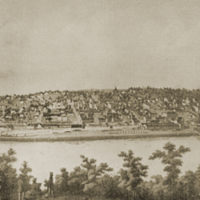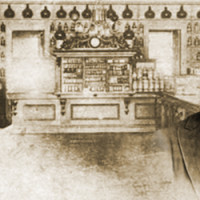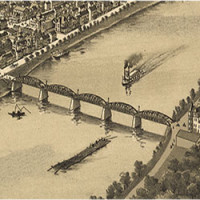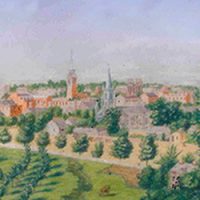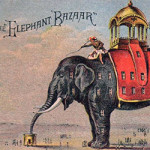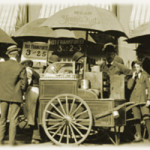
Prior to the passage of the Pure Food and Drug Act of June 30th 1906, there existed many merchants and purveyors who foisted various toxic preparations and other snake oils on the American public. Tonics for depression, pills for melancholy, emollients for impotence, even arsenic tablets for beauty — these were the kinds of patent medicines available and on the shelves of the typical American corner drugstore at the dawn of the 20th century.

Coca Cola, originally a hangover and cure-all formulated by an Atlanta druggist, is a well known example of another such tonic which can trace its origins to the late 19th century; its original formula included the addition of cocaine as an adjunct.
The pharmacists of Alexandria, Virginia were no different. A small city-town outside of the nation’s capital, the town hosted a half-dozen drug stores by the end of the 19th century.
Charles G. Lennon was one such pharmacist and druggist. Beginning his operation in 1888, Lennon acquired his store at 616 King Street from another druggist, and parlayed his trade for several decades thereafter. Like his contemporaries, Lennon was a prolific advertiser. He placed numerous ads for miracle cures.
Reflective of the times, tonics and other snake oils, including treatments for nervousness, alcoholism, and stress were prolifically advertised throughout local newspapers.
One such example was his Steel & Pennyroyal Treatment. Marketed at the time as a means to improve a lady’s complexion, the product contained pennyroyal leaves — a plant similar in fragrance to spearmint. Although pennyroyal was commonly used as a traditional culinary herb, folk remedy, and abortifacient, its active essential oil is pulegone, a highly toxic compound that severely affects liver and uterine functions.

Fortunately, the continued existence of such patent medicines and snake-oils came to an eventual end. Beginning with the passage of the Pure Food and Drug Act of June 30 1906, medicines for the first time required truth-in-labeling and established strict labeling requirements over the ingredients and additives which could be included in their preparations.

Previously, many patent medicines were sold with “secret” ingredients and misleading labels, as evidenced by these advertisements.
Adjuncts such as alcohol, opiates, cocaine, and other addictive narcotics had to be conspicuously and accurately labeled on the preparations where they were additives.
Beginning in the mid 19th century, and for decades thereafter, most drug stores and pharmacies in small-town America also had soda fountains.
In addition to providing a means for pharmacists to concoct their own “in-house” tonics, druggists saw soda fountains as a way to entice customers into their stores by providing them with thirst-quenching refreshments.
Charles G. Lennon was no different than the other druggists of his day.
Many of these druggists who also had soda fountains within their establishments had private tokens struck. Many of these tokens were known as “Good Fors,” and commonly were good for one soda fountain drink.
Numismatic Specimens
Below please find a C. G. Lennon Soda Fountain token discovered by the author in 2014. At the the time of this article’s original publishing, it was neither listed in Rulau or Schenkman. At the time, no references to the token existed.
Since its discovery, however, a second edition of Schenkman’s Virginia Tokens book was published, and it has been added to the reference.
Incuse struck, the token is approximately Extra Fine in grade. It was struck in nickel, on a think planchet, and is 27.5mm in diameter. Schenkman’s new catalog number for the token is VA-A1080-L5.

In May 2016 a second example of this variety was discovered and subsequently acquired by the author. It is approximately VF-25 in grade. No other examples beyond the two illustrated here are presently known to exist:

In the Fall of 2015 a hoard of later Charles G. Lennon tokens appeared for sale on eBay. Based on the token’s style, it is estimated that it was struck sometime after the aforementioned incuse tokens, sometime in the 1890s. Per Schenkman’s Virginia Tokens book, it is listed as VA-A1080-L6-5. All of the specimens that had been offered for sale on eBay during the Fall of 2015 were of AU or better grade. The author’s example is below:

Aaron Packard ![]()
Notes and Sources
- Alexandria Gazette Newspaper Advertisements, January-February 1900
- Boyd’s directory of the District of Columbia, W.H. Boyd, 1908
- ‘C.G. Lennon succeeds A.A. Warfield of Alexandria,’ Western Druggist Volume 10, Engelhard, 1888
- The Era druggists’ Directory Volume 11, D.O. Haynes & Co., 1905
- The Pharmaceutical Era Volume 19, D. O. Haynes & Co., 1898
- The Library of Congress Digital Archives
- The City of Alexandria Library System
- ‘What the Food Law Saves Us From,’ Dr. Edward A. Ayers, The Worlds Work, August 1907
- Correspondence with David Schenkman
- Virginia Tokens, 2nd Edition, David Schenkman, VNA Publishing, ©2015, pg.8
- New York’s Crystal Palace & The H.B. West Tokens - November 6, 2019
- Edward Aschermann’s Cigar & Tobacco Tokens - November 2, 2019
- George T. Hussey & His Special Message Tokens - October 30, 2019

